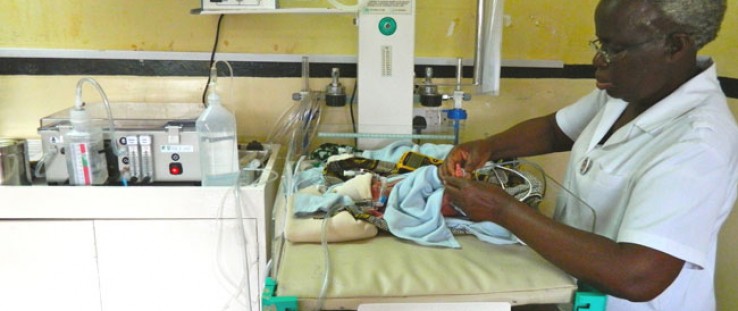 A newborn with respiratory distress at Queen Elizabeth Central Hospital in Blantyre, Malawi, breathes easier with the help of the Pumani bCPAP device.
Jocelyn Brown
A newborn with respiratory distress at Queen Elizabeth Central Hospital in Blantyre, Malawi, breathes easier with the help of the Pumani bCPAP device.
Jocelyn Brown
 A newborn with respiratory distress at Queen Elizabeth Central Hospital in Blantyre, Malawi, breathes easier with the help of the Pumani bCPAP device.
Jocelyn Brown
A newborn with respiratory distress at Queen Elizabeth Central Hospital in Blantyre, Malawi, breathes easier with the help of the Pumani bCPAP device.
Jocelyn Brown
Effective neonatal care has come to be expected in the developed world; but in countries like Malawi, many mothers fail to see their baby live beyond a single day. Among the many causes of infant death in the developing world, respiratory illness tops the list.
For every 100 babies born in Malawi, 18 are born premature and with a heightened risk for respiratory distress syndrome, according to “Born Too Soon: The Global Action Report on Preterm Birth” from the World Health Organization. This life-threatening breathing condition is the leading cause of deaths in preterm infants, and will most likely continue to be unless the technology for its remedy is brought to the developing world.
Jocelyn Brown
Age: 24
Device: Pumani bCPAP
Mission: To implement a low-cost newborn breathing device in Malawi's hospitals and reduce millions of preventable infant deaths.
With this grueling reality in mind, one young bioengineering student, 24-year-old Jocelyn Brown, and a team of other students at Rice University developed a low-cost breathing device to reduce infant mortality. The idea was developed through Beyond Traditional Borders, the undergraduate education initiative of Rice 360°: Institute for Global Health Technologies, with mentoring from faculty at Rice University and Baylor College of Medicine. Through the program, which gives students a chance to do research abroad, Brown and several colleagues collaborated with physicians at Queen Elizabeth Central Hospital (QECH) in Blantyre, Malawi, to pinpoint the developing world’s greatest medical needs.
During one visit in July 2009, a physician suggested that students from the Rice 360º program design a low-cost, durable bubble Continuous Positive Airway Pressure (bCPAP) device. The nasal-prong device, which essentially forms a pressurized seal over the airways and forces air in and out of the lungs, is commonly used in the developed world to treat infants with ailing respiratory systems, but the $6,000 price tag often puts the device out of reach for developing world delivery rooms.
Although QECH, the largest hospital in Malawi, had oxygen therapy, or bottled oxygen delivered through nasal prongs, the treatment is significantly less effective than its more high-tech cousin; bCPAP increases the survival rate of infants with respiratory distress to 70 percent, as opposed to 25 percent with just oxygen.
To bridge this financial gap and open the door for proper infant care, Brown and her classmates began testing prototypes in the fall of 2009 for their senior engineering design project. They came up with a rugged bCPAP device that could be built for $160, a fraction of the usual price. Although nearly 38 times cheaper, the rugged model delivers the same therapeutic pressure as the more expensive device does in the developed world. One difference is that a commercial bCPAP provides humidification, while Brown’s device avoids the high cost of that installation by drawing in room air for sufficient humidity.
Scaling to an Entire Continent
In a prototypical bCPAP device, pressurized air is delivered via prongs into the infant’s nostrils to keep the lungs open, with controls for air flow, pressure and oxygen. This is also the case for Brown’s latest design called the Pumani bCPAP, although in this version, the primary cost savings comes by replacing wall air flow or a commercial flow generator with inexpensive aquarium pumps that are designed to be easy to repair and run for years at a time.
Because of its simple design, bCPAP requires little maintenance. This and the cost factor, says Brown, gives hospitals in developing countries access to the lifesaving equipment on a broad scale, for the first time.
After winning $250,000 in seed-grant funding from the USAID-backed July 2011 Saving Lives at Birth Grand Challenge—the first in the multi-donor Grand Challenge series where applicants are called on to produce original ideas to target a particular problem—Brown said the Rice team was able to kick-start a rigorous clinical trial of her prototype in Malawi.
In the following months, Brown’s team brought the device to QECH to launch a nine-month clinical trial, create a training program for hospital staff and engineer several bCPAP prototypes for commercial manufacture. To gather feedback and adjust their efforts to meet local needs, the team held a countrywide stakeholders meeting as well.
USAID stresses the importance of these test stages to refine the product and adapt to any challenges that arise before broad-scale implementation. Brown said these required steps helped her team fine-tune the product for its eventual roll out across Malawi.
“We have continued to receive feedback from users about the design of the bCPAP, and the next version of the device has been created based on their feedback,” Brown said. “We know that the design improvements we’ve made and the lessons we’ve learned while conducting the trial at Queen Elizabeth Central Hospital will be very beneficial when we scale bCPAP to the other central and district hospitals in Malawi.”
Scaling up across the Southern African country is part of the master plan for Rice’s bCPAP. This year, the device is one of three finalists nominated for a Saving Lives at Birth transition grant worth $2 million. The goal is to implement the technology, through partnership with the Malawi Ministry of Health and local commercial and government entities, in all central and district hospitals in Malawi within three years, says Brown, and develop an education and awareness campaign while assessing the product’s cost-effectiveness. It is estimated that, if each central and district hospital in Africa receives sufficient bCPAP devices to treat all babies with respiratory disease, more than 178,000 lives could be saved each year.
Brown says the initial data from the testing period shows that the bCPAP therapy significantly reduces infant mortality rates in a low-resource setting, such that if the innovation is widely distributed throughout the African continent where nearly 1 million children die within a week of birth, neonatal mortality rates could be reduced by up to a third.
“Now that we’ve implemented bCPAP in one central hospital, we have a greater understanding of the staffing and spacing requirements,” Brown said. “We are currently planning the next phase of bCPAP roll-out, which will include implementing a bCPAP ‘SmartCart,’ containing bCPAPs and other required equipment to help babies breathe to all four central and 27 district hospitals in Malawi, as well as implementing a video campaign to educate mothers about bCPAP.”
With an end goal of saving lives at birth while simultaneously creating sustainability and boosting the economy, Brown said the team plans to work with local manufacturers to determine if bCPAP components can be made or assembled locally.
“Global health innovation needs to be a collaborative, iterative process,” Brown said. “Because the idea to develop the bCPAP came from our partners in Malawi, their need for the device has been a driving force for the students and engineers in the United States.
“In the past three years, we have transported at least three different versions of the bCPAP to Malawi for feedback, and we plan to continue to incorporate users’ suggestions into future designs. There is so much medical equipment that breaks or goes unused in the developing world, and I think we need to listen to the nurses and doctors who work in these settings to understand their needs, and not just donate or design equipment that may ultimately make their jobs even more difficult.”







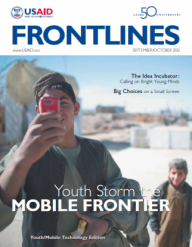

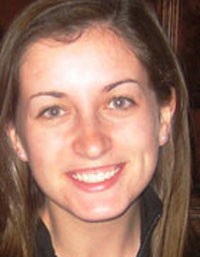
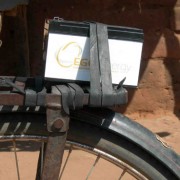

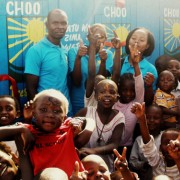
Comment
Make a general inquiry or suggest an improvement.